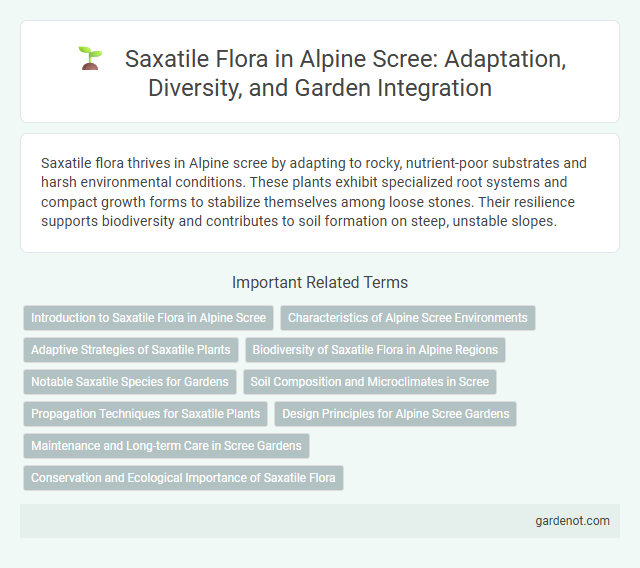Saxatile flora thrives in Alpine scree by adapting to rocky, nutrient-poor substrates and harsh environmental conditions. These plants exhibit specialized root systems and compact growth forms to stabilize themselves among loose stones. Their resilience supports biodiversity and contributes to soil formation on steep, unstable slopes.
Introduction to Saxatile Flora in Alpine Scree
Saxatile flora in alpine scree consists of specialized plant species adapted to harsh, rocky environments with minimal soil and extreme temperature fluctuations. These plants typically exhibit traits such as deep root systems, drought resistance, and compact growth forms to survive in unstable scree slopes. Saxatile flora play a crucial role in stabilizing scree deposits and supporting biodiversity in alpine ecosystems.
Characteristics of Alpine Scree Environments
Alpine scree environments feature loose, rocky debris with poor soil development, creating extreme conditions of temperature fluctuation and limited water retention that challenge Saxatile flora adaptation. These plants exhibit specialized traits such as deep root systems for anchorage, drought resistance, and slow growth to survive nutrient-poor substrates and mechanical abrasion. High UV radiation and wind exposure further influence their morphology, favoring low, cushion-like growth forms with protective leaf structures.
Adaptive Strategies of Saxatile Plants
Saxatile plants in alpine scree environments exhibit adaptive strategies such as deep root systems to anchor in unstable rocky substrates and specialized leaf structures to reduce water loss under intense sunlight and wind exposure. These plants often possess drought-resistant traits and engage in symbiotic relationships with soil microbes to enhance nutrient uptake in nutrient-poor conditions. Their growth cycle is typically synchronized with short alpine summers, maximizing reproductive success despite harsh climatic constraints.
Biodiversity of Saxatile Flora in Alpine Regions
Saxatile flora in alpine scree habitats exhibit remarkable biodiversity, thriving in rocky, nutrient-poor substrates with specialized adaptations such as deep root systems and drought resistance. Key species include Saxifraga oppositifolia and Androsace alpina, which contribute to stabilizing scree slopes and supporting microhabitats for invertebrates. This unique plant community plays a critical role in alpine ecosystem resilience and nutrient cycling, highlighting the importance of conserving these fragile environments.
Notable Saxatile Species for Gardens
Notable saxatile species for alpine gardens include Saxifraga oppositifolia, known for its vibrant purple flowers and resilience in rocky terrains. Saxifraga paniculata thrives in well-drained scree, offering delicate white blooms that attract pollinators. These species exemplify the adaptability of saxatile flora, enhancing garden biodiversity with their unique alpine characteristics.
Soil Composition and Microclimates in Scree
Saxatile flora in alpine scree thrives on well-drained, mineral-rich soil composed primarily of weathered rock fragments and coarse sediments, which provide essential nutrients and oxygen for root systems. Microclimates within scree slopes, characterized by temperature fluctuations, variable moisture levels, and sun exposure, create diverse niches supporting specialized plant adaptations. These environmental factors influence species distribution, promoting biodiversity in typically harsh alpine ecosystems.
Propagation Techniques for Saxatile Plants
Propagation techniques for saxatile plants involve seed sowing, division, and cuttings to ensure successful establishment in alpine scree environments. Seed sowing requires stratification to simulate natural cold conditions, enhancing germination rates for Saxatile flora. Division and semi-hardwood cuttings taken during the growing season enable vegetative propagation, preserving genetic traits and promoting healthy root development in rocky substrates.
Design Principles for Alpine Scree Gardens
Saxatile flora thrives in alpine scree gardens by mimicking natural rock-slide environments with well-drained, gritty substrates and strategic rock placement to enhance root aeration and water runoff. Designing these gardens involves selecting hardy, low-growing saxatile species such as Saxifraga and Sempervivum that tolerate extreme temperature fluctuations and nutrient-poor soils. Optimal garden design also emphasizes microhabitat diversity to replicate alpine scree conditions, promoting species resilience and sustainable growth in challenging environments.
Maintenance and Long-term Care in Scree Gardens
Saxatile flora thrives in alpine scree gardens through well-drained, rocky substrates mimicking natural scree conditions. Maintenance involves minimal watering, avoiding soil compaction, and removing invasive species to preserve native biodiversity. Long-term care emphasizes periodic soil aeration and monitoring microclimate changes to sustain healthy growth and prevent erosion.
Conservation and Ecological Importance of Saxatile Flora
Saxatile flora thriving on alpine scree plays a critical role in soil stabilization and nutrient cycling, ensuring the persistence of fragile mountain ecosystems. These specialized plants offer vital habitats and food sources for endemic fauna, fostering biodiversity within harsh environments. Conservation efforts targeting saxatile species protect genetic diversity and enhance ecosystem resilience against climate change and human disturbances.
Saxatile flora Infographic

 gardenot.com
gardenot.com